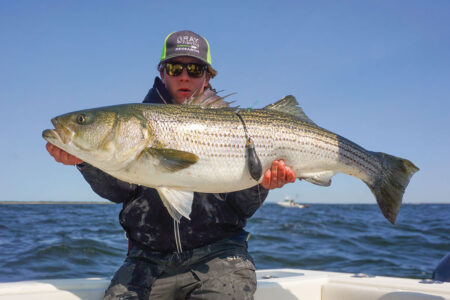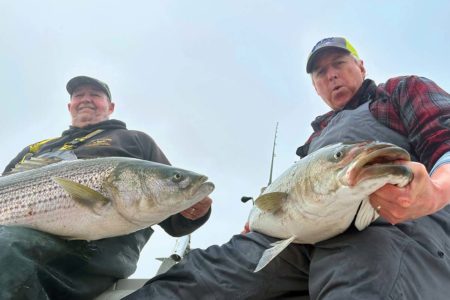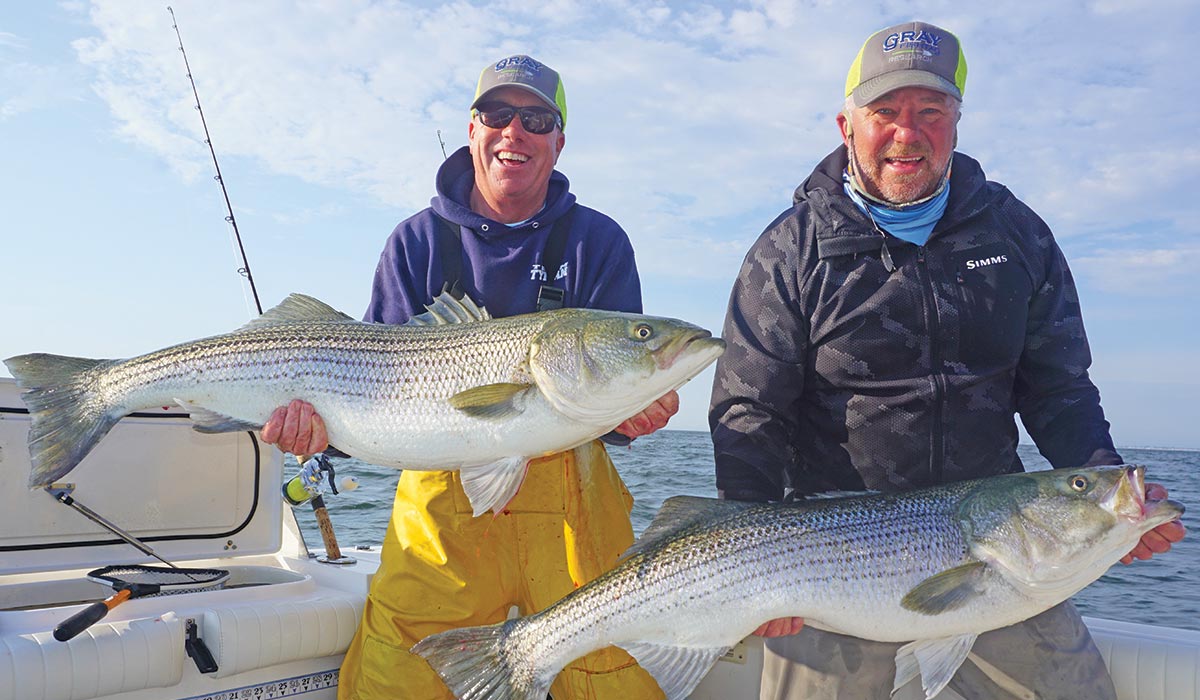
After overcoming “COVID” related obstacles, the groundbreaking Northeast Striped Bass Study is underway again!
“I don’t know Chuck, I think you can get a bigger one.”
The striper in the net was 46 inches long, a solid 36-pounder. She was a good fish by most standards; but perhaps in relative terms, she was nothing like either the 52- or 54-pounder caught the day before aboard Tyman, a 28-foot True World run by striper fanatic Chuck Many.
Affixing a green Gray FishTag Research spaghetti tag just to the port side of her dorsal, angler Dave Glassberg named the fish Ellie and safely slid here back to swim again. Minutes later, Many netted a second good fish for Bob Bowden, a 43-incher.
Looking over at Chuck, I asked, “We can go bigger, right?”
Superstitiously speaking, sending that fat upper 30-pound striper named Bella B over the side of the gunnel was probably worse than pulling a bunch of bananas out of a canyon bag on an overnighter. Not one personally to bet on the favorite pony in the big race, I pushed for the trifecta.
Our Gray FishTag Research tagging team set 38 inches as our minimum size for the 2020 Northeast Striped Bass Study; from the looks I was getting onboard Tyman after the first two qualified candidates were set free without a satellite tag, I began to wonder if we weren’t pressing our luck.
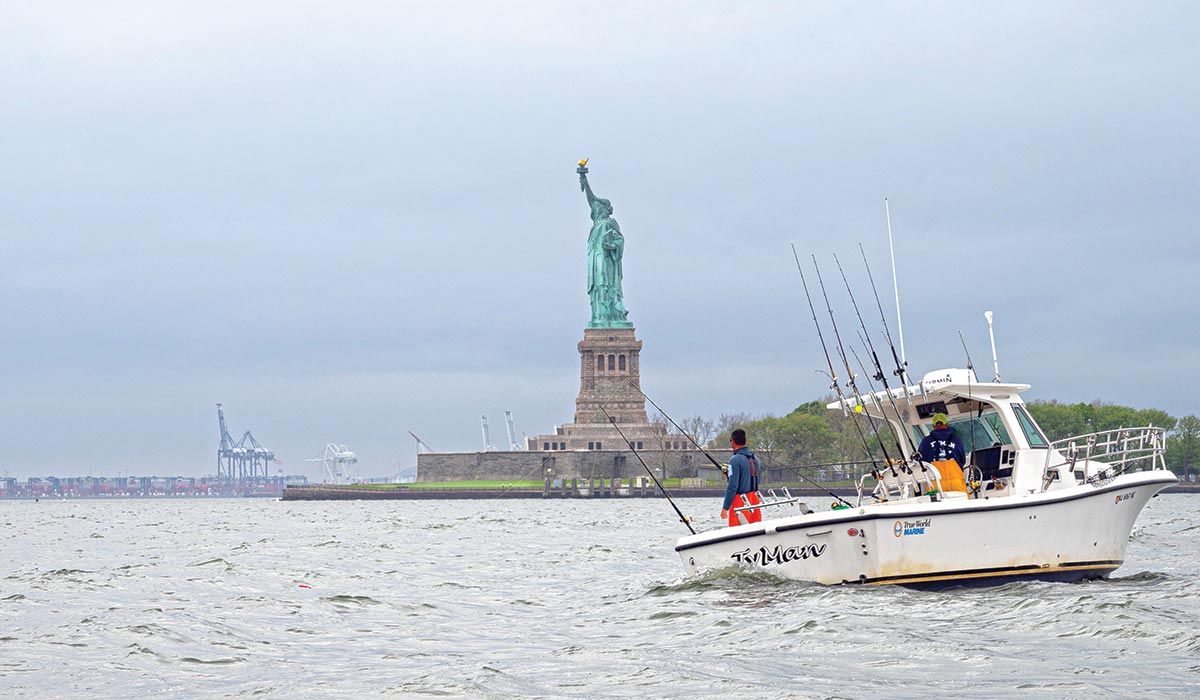
Down, Not Out
The inaugural Northeast Striped Bass Study successfully deployed a pair of high-tech satellite tags on two post-spawn striped bass leaving the Hudson River last spring. It was the morning of May 21 that a trophy-hunting team comprised of the nonprofit Gray FishTag Research, Navionics and The Fisherman stepped aboard Rocket Charters in lower Manhattan in search of quality tagging candidates. The trip would include an onwater transfer to the Highlands, NJ based Fin Chasers Charters crew for a successful double-tide of striper fishing in the shadow of the Statue of Liberty.
While upper 40- to lower 50-inch stripers were a strong possibility, the team set the 2019 size limit for quality candidates at 34 inches. Before the day was out, a 34- and 42-inch pair of striped bass named Liberty and Freedom were released with Wildlife Computer MiniPAT devices attached. The tags archive data on water temperature, pressure and light conditions; programmed to stay affixed to the fish for five months, the tags by design will float to the surface at the end of the cycle where they relay summaries of stored data via Argos Satellites back to the staff at Gray FishTag Research.
PSATs have been used only on a limited basis in striped bass research, typically to track a week or two of post-release behavior for gathering mortality estimates. But five months of tracking with the latest, greatest technology on the market had not been done before. By last fall, both tags had miraculously been recovered, one along the beach in Massachusetts during the summer, the second down the Jersey Shore in October, roughly 13.5 miles away from where our Tyman crew was now releasing 40-inch-plus class fish.
Heading into 2020, the Gray FishTag Research project team had big plans. For starters, a fundraising effort resulted in major contributions from industry heavyweights like Navionics, Tsunami Tackle, AFW/HiSeas, Southernmost Apparel and the Recreational Fishing Alliance through the Manhattan Cup; it was soon bolstered by individual donations from Fisherman readers, regional advertisers, and local fishing clubs.
“We were looking at six, maybe seven of the MiniPSAT devices,” said Mike Caruso, publisher of The Fisherman and an advisor for Gray FishTag Research. “The plan was to have multiple boats ready to go at one time, with a full Gray FishTag Research team in New York again during the week of May 18. It was going to even more groundbreaking than in 2019.”
Suffice to say, the COVID-19 pandemic put the kibosh on those grand plans. A strategic session between anglers and researchers planned for the Salt Water Fishing Expo in March was cancelled, as was the next two months of fishing with anyone other than immediate family members. Production of the tags themselves by Wildlife Computers in the state of Washington was shut down, and the entire project was suddenly up in the air.
While the coronavirus may have knocked us down; it did not knock us out!
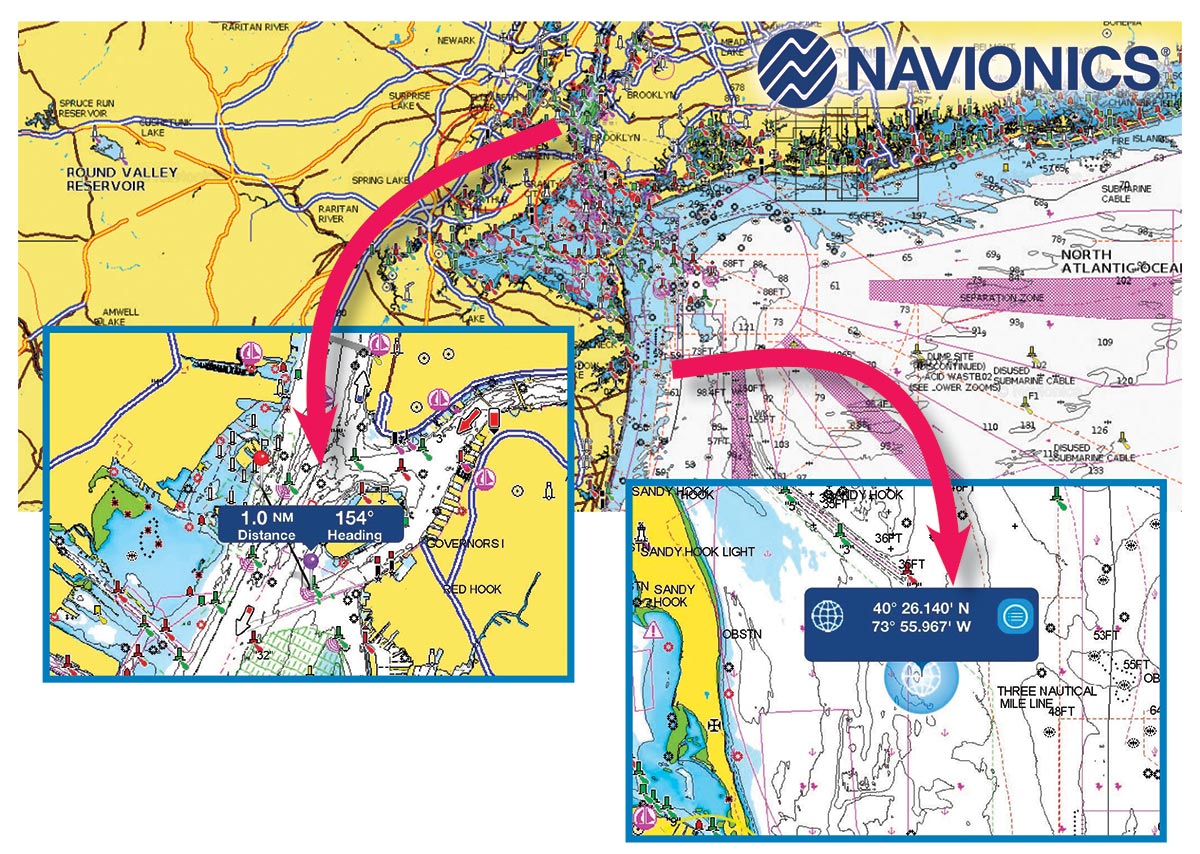
Third’s a Charm
While Northeast states were often labeled “ground zero” during the global pandemic, the state of Washington was hit incredibly hard and saw even greater closures and restrictions than most. When things started slowly reopening there this spring, the crew from Gray FishTag Research was quick to inquire about MiniPSAT devices for the Northeast Striped Bass Study.
On April 28, I received an email from Roxanne Willmer from Gray FishTag Research with optimistic news. While Wildlife Computers in Washington was mostly closed during the pandemic, scientists were still working on the specific programming of the satellite tag for the nature of our study. “I have been in touch with our rep throughout the past weeks and yesterday when we spoke I was advised that they can get two tags completed and sent for the study,” Willmer said of the effort, explaining how the team at Gray FishTag Research was able to secure the tags, just in time for the study.
The first two SAT tags showed at my door on May 11, with the tag applicator sticks and catch cards arriving about a week later.
Roughly one week off our originally planned deployment schedule of May 18, 2020, we got together by phone with the first two of three deployment teams (Tyman and Fin Chasers) and set an immediate plan to hit the Hudson for post-spawn stripers, the same location as in 2019. Regrettably, the New York Harbor bite was slow in between moons, and the afternoon outgoing tide of Thursday, May 28th looked to be plagued by stiff SE winds. So when Chuck Many called the day before about the epic bite he was having with the Wakefield brothers, Joel, Lee and Seth, I was back with the Gray FishTag Research team to discuss options.
“We simply don’t have much to report right now in the lower Hudson,” I explained to the folks at Gray FishTag Research. “There is still a reported spawn up the Hudson near Kingston, but what we do have right now is a good body of monster fish from what we believe is the Chesapeake stock just off the beach.” Bill Dobbelaer, President of Gray FishTag Research listened intently alongside Willmer, while Caruso jotted notes about the next day’s deployment plan. And we called an audible.
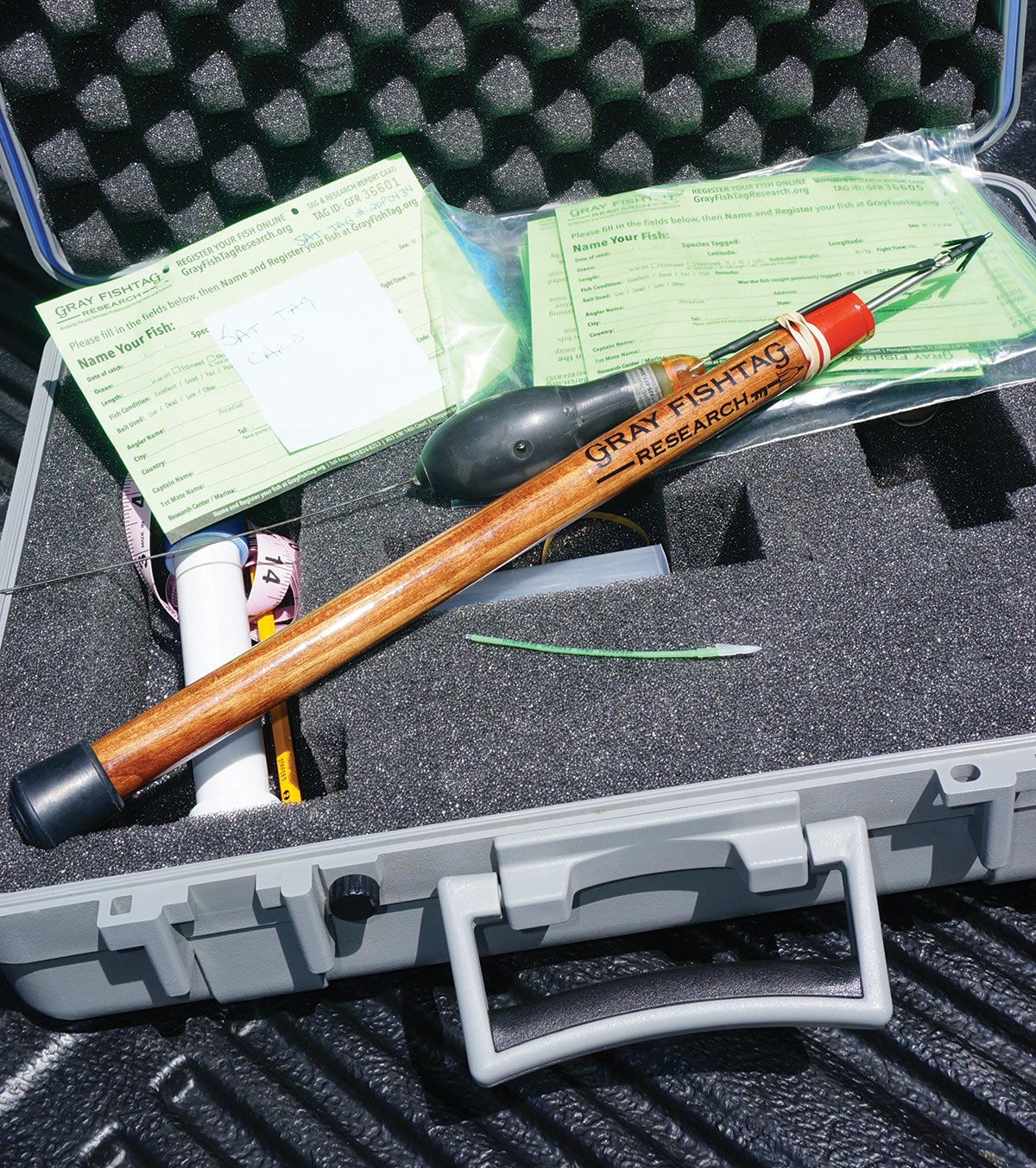
The two boats would still meet at Captains Marina in Staten Island on the afternoon of May 28th in search of a pair of post-spawn Hudson River stripers. But just in case, we would hedge our bets a touch by starting the morning 2-1/2 miles east of the Sandy Hook in New Jersey in search of those specimens boated the prior day aboard Many’s True World.
When Glassberg reeled in our third fish that morning and laid her to rest on the measuring board, the 46-1/2-inch length was impressive enough; but the overall girth and the ample shoulders on this 43-pound striper made her immediately tag-worthy. After placing a damp towel across her head, we picked off a scale, sank the MiniPSAT device into her starboard side, and a second green Gray FishTag Research spaghetti tag into her port shoulder. After a quick snapshot, we watched as Many swam her with the current until she kicked off into the depths.
After releasing Rona, we slow-trolled live eels under planer boards – one of Many’s surefire methods of fishing for Jersey Shore giants – for another hour and a half without another touch. Luckily, I didn’t let it ride on a superfecta!
The Cora-rona Cure
The two teams worked their butts off in the SE chop in the afternoon, tossing livies against the stanchions of the Verrazano, drifting across Robbins Reef, and ultimately anchoring up on our 2019 marks alongside the Statue of Liberty. A third planned deployment team consisting of Jerry Gomber from Tsunami Tackle aboard Capt. Howard Owens’ 26-foot Sailfish was fishing down on Raritan Bay with great success. “I was by myself all morning,” Owens texted me that afternoon. “My first fish was a 54-inch.”
We all knew where the bite was; in fact, on the way into Great Kills on Staten Island to meet the rest of the team the Many’s crew stumbled onto a bunker busting blitz of big stripers crashing the surface just off Sandy Hook. We quickly deployed another three Gray FishTag Research spaghetti tags in fish to 40 pounds before leaving the fish to go find fish where they simply weren’t. At the end of a long day, with one MiniPSAT tag deployed out front, our immediate goal was to find another quality fish in the same spot as in 2019 for control purposes in the name of science. As they say, the best laid plans.
In another Gray FishTag Research meeting the following afternoon, Wilmer and Dobbelaer delivered more good news; another SAT tag was being shipped to our Gray FishTag Research team for another deployment. With hopes of another wave or two of big stripers tumbling out of the Hudson River post-spawn in June, we called a second audible.
With two tags in the bush and the other still in hand, I immediately texted Many and a second day was set for tag #2. With big, old, fat, fecund, female fish (BOFFFs) running North Jersey’s front beaches, occasionally exploding on bunker schools in sub 60-degree water temps, we hopped aboard Tyman out of Gateway Marina in the Highlands a second time at 5:30 a.m. on June 3.
Together again with Many and Glassberg, I was pleasantly surprised to also find old friend and former Striper Mania skipper Lou Grazioso onboard to manage the day’s fishing. Many deploys upwards of eight or nine outfits at one time while drifting eels and live bunker under floats and planer boards to tempt big stripers off the bottom. Just 15 minutes after setting our spread, Grazioso – in his best Gloucester accent – shouted from his position in front of the fishfinder screen, “we got a streaker Jay.”
It was appropriate enough; the Northeast Striped Bass Study was born in a Gray FishTag Research advisory meeting when Caruso, former Navionics staffer Paul Michele, and Hard Merchandise’s Capt. Dave Marciano wondered aloud about putting SAT tags in striped bass. In an instant the Shimano Torium clicker aboard Tyman was screaming like a Wicked Tuna episode, as Glassberg went to work again on a big bass at the other end of the line. Minutes later, a healthy, 45-3/4-inch striper was laying in the same measuring board where literally thousands of striped bass have rested before. She was green, she was clean, and quite honestly she was perfect.
Thanks to Gray FishTag Research, The Fisherman is proud to continue in the efforts of this powerful scientific work; it wouldn’t be possible of course without the generous financial support of valued partners including Navionics, Tsunami, AFW/HI Seas, Southernmost Apparel, the Recreational Fishing Alliance (Fisheries Conservation Trust) and hundreds of Fisherman readers and clubs including Berkeley Striper Club, the Hudson River Fishermen’s Association, High Hills Striper Club and others.
Gray FishTag Research is a 501(c)(3) non-profit organization; an international and fully interactive fish tagging program, it’s powered by the world’s largest network of fishing professionals consisting of approximately 10,000 charter boat captains and mates. The data collected by Gray FishTag Research on fish species across the globe is analyzed and used for scientific purposes and shared with any interested parties at no cost.
To learn more about Gray FishTag Research and how you can make a charitable donation to the Northeast Striped Bass Study go to grayfishtagresearch.org.
The team could’ve rolled the dice again, looking for that elusive 50-pounder. Monday morning quarterbacking again the following day as I put pen to paper for this story, I had to laugh. The team would enter the names of another 11 stripers that morning on catch cards, each stuck with green streamer tags from Gray FishTag Research in hopes of returns somewhere down the road; we even tagged a 19-inch bluefish which got a little too close to the hooked-headend of a live eel. But that first fish of the morning – a 35-pounder named Cora – was deployed with the second of our first two Wildlife Computers MiniPSAT devices. She would be the largest for the day.
Back at the fishfinder, we watched as Cora streaked straight back towards to the bottom, pulling up hard and heading north off the screen; northerly being a path one might expect of these spring run giants. Freedom and Liberty in 2019 didn’t exactly do as predicted of course, heading E/SE to the Northeast Canyons for the summer.
With another SAT tag coming north in another week or so for the Tsunami and Navionics deployment teams – hoping to catch a few of those big breeders falling out of the Hudson before the month of June is out, and perhaps with this whole coronavirus drama shrinking in the rearview mirror – I look forward to hearing more from Cora and Rona again sometime in October. But first, we have to find their Hudson River sisters!
Details to follow online at TheFisherman.com, and in our August edition!


